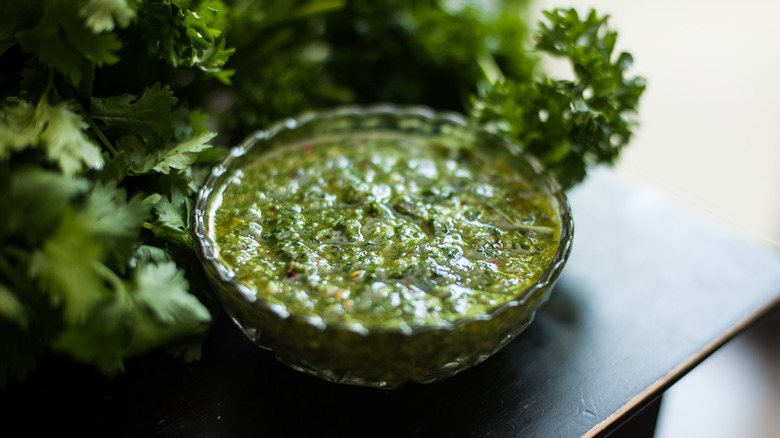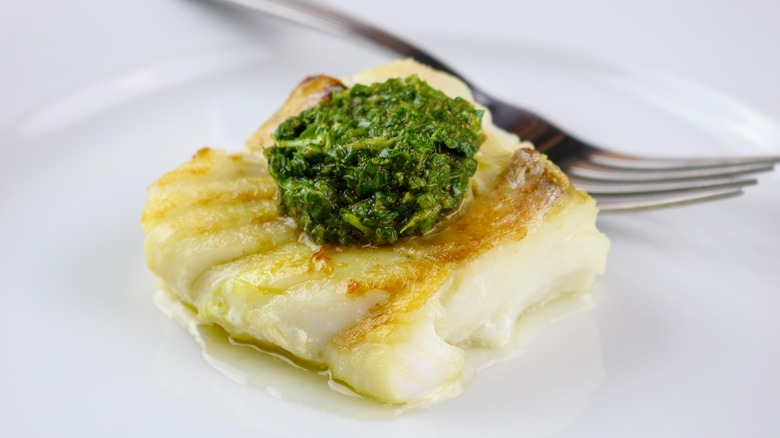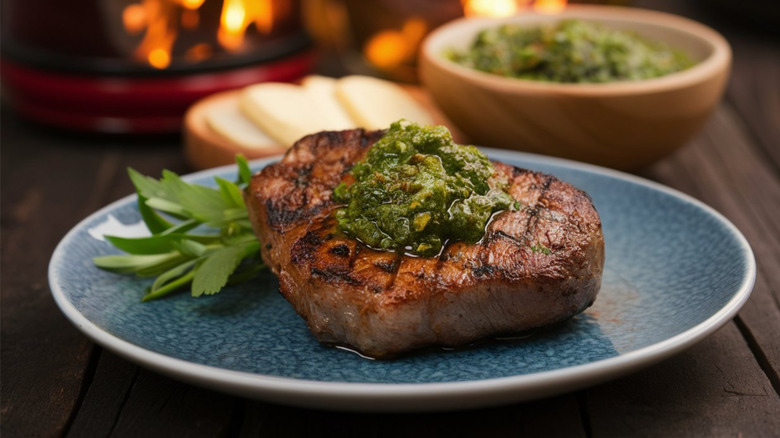Chermoula Vs Chimichurri: How Do These Sauces Differ?
In the vast world of green sauces, there are many that look similar, even though they have key differences. For example, chermoula and chimichurri are two vibrant green sauces chock-full of flavor, yet they have completely different culinary backgrounds. Chermoula hails from North Africa, particularly Morocco, while chimichurri's origins trace back to Argentina.
Aside from their countries of origin, the main differences between these two sauces are their ingredients, uses, and flavor profiles. Both are beloved for being versatile enough to pair with various dishes, but each has its own popular hits. Chermoula is typically used in an array of North African and Mediterranean dishes, while chimichurri is synonymous with Argentine grill culture.
Both sauces get their green hue from fresh herbs, and while they might resemble pesto, there are no nuts or cheeses involved in either of these sauces. They're both typically made with a mortar and pestle or food processor, but you can also use a solid whisking session to emulsify the sauces. And while there isn't exactly a one-size-fits-all recipe for either of these sauces, there are some common ingredients that define each. Both are herb-forward, but chermoula leans more into its warm spices while chimichurri has a sharper, tangier kick.
Chermoula is a North African flavor bomb
Chermoula often begins with "el ras hanout" (meaning "top of the shop"), which blends spices like cumin and coriander. For the herb infusion, most versions of chermoula include parsley, mint, and cilantro. Additionally, this sauce is often flavored with preserved lemons and garlic, and its consistency comes from the addition of olive oil. From there, cooks can get creative, incorporating everything from chilis to ginger to onion and thyme. The flavor profile is complex, with the warm spices' earthiness balancing out the brightness from citrus and fresh herbs.
Now that we've covered what chermoula is, you may be wondering how to use it. Beyond its Moroccan home, chermoula is common in North African cuisines, specifically in places like Algeria, Libya, and Tunisia. In addition to pairing it with fish (a traditional matchup), you can use it to marinate chicken, lamb, or steak before cooking. Some even suggest mixing it into a side of rice or couscous. You can use it as a dip or a base for salad dressing, or you can incorporate it into a stuffing for seafood or meat. We also recommend slathering it on vegetables or bread or stirring it into stews, like this slow cooker chicken tagine.
Chimichurri is an herby Argentine classic
Chimichurri is popular far beyond Argentina (especially in Uruguay and Paraguay), and each place is home to occasional variations. Some chimichurri sauce recipes add red chili flakes, honey, or lemon, while others tweak the amounts of each ingredient. But the primary ingredients are generally fresh parsley, olive oil, vinegar, garlic, and oregano. This sauce is zesty and refreshing, with an acidic tang from the vinegar (or lemon) contrasting the peppery bite of fresh parsley.
Chimichurri is a classic match for asado (grilled meats), especially steaks. Just about everywhere throughout Latin and South America, you're unlikely to find a choripán (chorizo sausage in a bun) that isn't slathered in the stuff. But you can serve it with pretty much anything, from vegetables, fish, eggs, and rice to empanadas and bread.
While no one can agree on how chimichurri got its name, there are several theories. One says it comes from a mispronunciation of "Jimmy McCurry," an Irish immigrant said to have created the sauce. Others say it first appeared among 19th-century gauchos (a type of local cowboy). Yet another theory suggests British soldiers in the 1800s were responsible for the term because of how they requested curry with their food. Still others say the name stems from the similarly pronounced Basque word "tximitxurri," which came to Argentina through the Basque people's mass migration to the area in the 19th century. However, Argentinian historian Daniel Balmaceda told the BBC in 2021 that the word comes from the region's Indigenous Quechua people.


